Management and Operations: Leadership, Theories, and Objectives
VerifiedAdded on 2024/06/11
|22
|5237
|424
Report
AI Summary
This assignment provides a detailed analysis of management and operations, focusing on the roles and characteristics of leaders and managers within an organizational context, specifically referencing Amazon.com. It compares different leadership and management styles, examining theories such as situational leadership, system leadership, and contingency approaches. The report also explores key approaches to operations management, emphasizing the importance of operations in achieving business objectives. Furthermore, it assesses the factors within the business environment that impact operational management and decision-making by leaders and managers, providing a comprehensive overview of the subject matter.

MANAGEMENT AND OPERATIONS
Paraphrase This Document
Need a fresh take? Get an instant paraphrase of this document with our AI Paraphraser

Table of Contents
INTRODUCTION................................................................................................................................2
TASK 1- REPORT WRITING...............................................................................................................3
LO1...............................................................................................................................................3
P1- COMPARISON OF DIFFERENT ROLES AND CHARACTERISTICS OF A LEADER AND A
MANAGER................................................................................................................................3
LO2...............................................................................................................................................6
P2- EXAMINE HOW THE ROLE OF A LEADER AND THE FUNCTION OF A MANAGER APPLY IN
DIFFERENT SITUATIONAL CONTEXTS.......................................................................................6
P3- APPLY DIFFERENT THEORIES AND MODELS OF APPROACH, INCLUDING SITUATIONAL
LEADERSHIP, SYSTEM LEADERSHIP AND CONTINGENCY........................................................8
TASK 2............................................................................................................................................11
LO3.............................................................................................................................................11
P4- EXPLAIN THE KEY APPROACHES TO OPERATIONS MANAGEMENT AND THE ROLE THAT
LEADERS AND MANAGERS PLAY............................................................................................11
P5- EXPLAIN THE IMPORTANCE AND VALUE OF OPERATIONS MANAGEMENT IN ACHIEVING
BUSINESS OBJECTIVES...........................................................................................................13
LO4.............................................................................................................................................16
P6- ASSESS THE FACTORS WITHIN THE BUSINESS ENVIRONMENT THAT IMPACT UPON
OPERATIONAL MANAGEMENT AND DECISION-MAKING BY LEADERS AND MANAGERS.....16
CONCLUSION.................................................................................................................................18
REFERENCES...................................................................................................................................19
1
INTRODUCTION................................................................................................................................2
TASK 1- REPORT WRITING...............................................................................................................3
LO1...............................................................................................................................................3
P1- COMPARISON OF DIFFERENT ROLES AND CHARACTERISTICS OF A LEADER AND A
MANAGER................................................................................................................................3
LO2...............................................................................................................................................6
P2- EXAMINE HOW THE ROLE OF A LEADER AND THE FUNCTION OF A MANAGER APPLY IN
DIFFERENT SITUATIONAL CONTEXTS.......................................................................................6
P3- APPLY DIFFERENT THEORIES AND MODELS OF APPROACH, INCLUDING SITUATIONAL
LEADERSHIP, SYSTEM LEADERSHIP AND CONTINGENCY........................................................8
TASK 2............................................................................................................................................11
LO3.............................................................................................................................................11
P4- EXPLAIN THE KEY APPROACHES TO OPERATIONS MANAGEMENT AND THE ROLE THAT
LEADERS AND MANAGERS PLAY............................................................................................11
P5- EXPLAIN THE IMPORTANCE AND VALUE OF OPERATIONS MANAGEMENT IN ACHIEVING
BUSINESS OBJECTIVES...........................................................................................................13
LO4.............................................................................................................................................16
P6- ASSESS THE FACTORS WITHIN THE BUSINESS ENVIRONMENT THAT IMPACT UPON
OPERATIONAL MANAGEMENT AND DECISION-MAKING BY LEADERS AND MANAGERS.....16
CONCLUSION.................................................................................................................................18
REFERENCES...................................................................................................................................19
1

INTRODUCTION
Management of the organization can be described as the term where the managers and leaders
are majorly responsible for controlling and monitoring of the operations. The major core
functions of an organization are the management and operations that are interrelated with
each other. It refers to the administrative business practices that can create the highest level of
effectiveness within the workplace. It is very helpful for the company to maximize its profit
rate; by which positive outcome can be acquired. With the proper use of technical terms and
the other strategies; it is possible to attain the goal and enhance proficiency accordingly. This
assignment covers the aspect of managers and leaders with the different roles and
characteristics towards proper functioning of the organization. Some of the different theories of
leadership and management will also be described in manner; that helps in situational context
for managing the operations successfully.
2
Management of the organization can be described as the term where the managers and leaders
are majorly responsible for controlling and monitoring of the operations. The major core
functions of an organization are the management and operations that are interrelated with
each other. It refers to the administrative business practices that can create the highest level of
effectiveness within the workplace. It is very helpful for the company to maximize its profit
rate; by which positive outcome can be acquired. With the proper use of technical terms and
the other strategies; it is possible to attain the goal and enhance proficiency accordingly. This
assignment covers the aspect of managers and leaders with the different roles and
characteristics towards proper functioning of the organization. Some of the different theories of
leadership and management will also be described in manner; that helps in situational context
for managing the operations successfully.
2
⊘ This is a preview!⊘
Do you want full access?
Subscribe today to unlock all pages.

Trusted by 1+ million students worldwide

TASK 1- REPORT WRITING
INTRODUCTION-
In this task, different roles and characteristics of leaders and the managers will be discussed.
The comparative study of roles and character of leaders and the managers with reference to
Amazon.com will be described with the range of diverse managerial theories. Some of the
situational and contingency approaches will be also described with the proper evaluation of
these contingency approaches.
LO1
P1- COMPARISON OF DIFFERENT ROLES AND CHARACTERISTICS OF A LEADER AND A
MANAGER
Management and leadership-
Management can be defined as the operational term that majorly consists of different activities
for setting up the strategies in order to coordinate the goals to employees. It refers to
monitoring of the services with the efforts of staff members towards accomplishing goals and
objectives (Bolden, 2016). It is the function for developing policies and standards of the
organization for its betterment and growth.
Leadership is the quality or an ability to lead others with the proper motivation for their certain
working criteria so that they can easily do their work in an effective manner towards the
attainment of the goals.
Manager-
A manager is a person, who is responsible for developing policies and directing the staff
members according to gain competitive advantages (Fiedler, 2015). The major role of the
manager is to creating, directing, and decision-making, coordinating, planning and monitoring
the operational services. Within the Amazon.com, the managers manage quality and control
the operations according to their working job role.
Leaders-
3
INTRODUCTION-
In this task, different roles and characteristics of leaders and the managers will be discussed.
The comparative study of roles and character of leaders and the managers with reference to
Amazon.com will be described with the range of diverse managerial theories. Some of the
situational and contingency approaches will be also described with the proper evaluation of
these contingency approaches.
LO1
P1- COMPARISON OF DIFFERENT ROLES AND CHARACTERISTICS OF A LEADER AND A
MANAGER
Management and leadership-
Management can be defined as the operational term that majorly consists of different activities
for setting up the strategies in order to coordinate the goals to employees. It refers to
monitoring of the services with the efforts of staff members towards accomplishing goals and
objectives (Bolden, 2016). It is the function for developing policies and standards of the
organization for its betterment and growth.
Leadership is the quality or an ability to lead others with the proper motivation for their certain
working criteria so that they can easily do their work in an effective manner towards the
attainment of the goals.
Manager-
A manager is a person, who is responsible for developing policies and directing the staff
members according to gain competitive advantages (Fiedler, 2015). The major role of the
manager is to creating, directing, and decision-making, coordinating, planning and monitoring
the operational services. Within the Amazon.com, the managers manage quality and control
the operations according to their working job role.
Leaders-
3
Paraphrase This Document
Need a fresh take? Get an instant paraphrase of this document with our AI Paraphraser
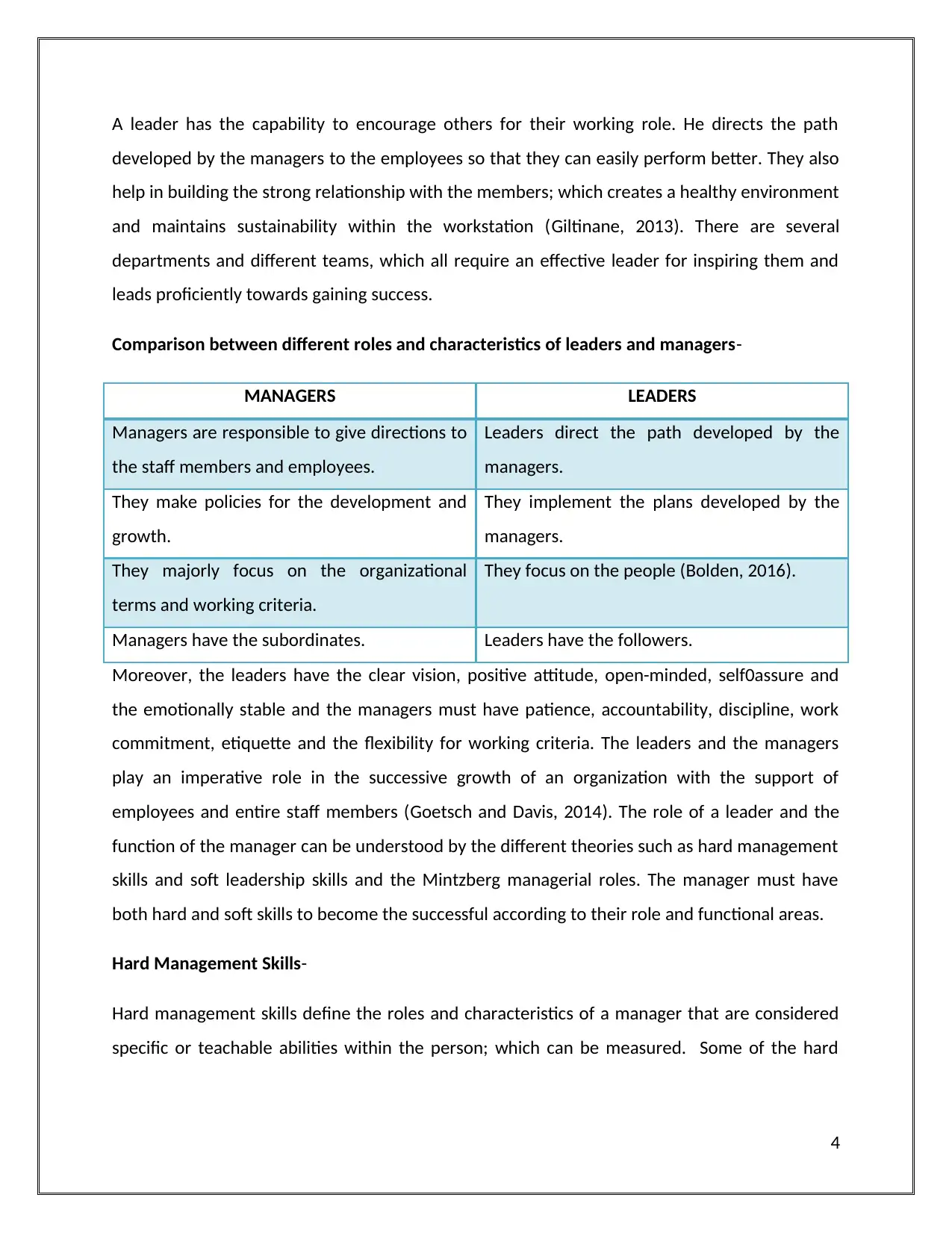
A leader has the capability to encourage others for their working role. He directs the path
developed by the managers to the employees so that they can easily perform better. They also
help in building the strong relationship with the members; which creates a healthy environment
and maintains sustainability within the workstation (Giltinane, 2013). There are several
departments and different teams, which all require an effective leader for inspiring them and
leads proficiently towards gaining success.
Comparison between different roles and characteristics of leaders and managers-
MANAGERS LEADERS
Managers are responsible to give directions to
the staff members and employees.
Leaders direct the path developed by the
managers.
They make policies for the development and
growth.
They implement the plans developed by the
managers.
They majorly focus on the organizational
terms and working criteria.
They focus on the people (Bolden, 2016).
Managers have the subordinates. Leaders have the followers.
Moreover, the leaders have the clear vision, positive attitude, open-minded, self0assure and
the emotionally stable and the managers must have patience, accountability, discipline, work
commitment, etiquette and the flexibility for working criteria. The leaders and the managers
play an imperative role in the successive growth of an organization with the support of
employees and entire staff members (Goetsch and Davis, 2014). The role of a leader and the
function of the manager can be understood by the different theories such as hard management
skills and soft leadership skills and the Mintzberg managerial roles. The manager must have
both hard and soft skills to become the successful according to their role and functional areas.
Hard Management Skills-
Hard management skills define the roles and characteristics of a manager that are considered
specific or teachable abilities within the person; which can be measured. Some of the hard
4
developed by the managers to the employees so that they can easily perform better. They also
help in building the strong relationship with the members; which creates a healthy environment
and maintains sustainability within the workstation (Giltinane, 2013). There are several
departments and different teams, which all require an effective leader for inspiring them and
leads proficiently towards gaining success.
Comparison between different roles and characteristics of leaders and managers-
MANAGERS LEADERS
Managers are responsible to give directions to
the staff members and employees.
Leaders direct the path developed by the
managers.
They make policies for the development and
growth.
They implement the plans developed by the
managers.
They majorly focus on the organizational
terms and working criteria.
They focus on the people (Bolden, 2016).
Managers have the subordinates. Leaders have the followers.
Moreover, the leaders have the clear vision, positive attitude, open-minded, self0assure and
the emotionally stable and the managers must have patience, accountability, discipline, work
commitment, etiquette and the flexibility for working criteria. The leaders and the managers
play an imperative role in the successive growth of an organization with the support of
employees and entire staff members (Goetsch and Davis, 2014). The role of a leader and the
function of the manager can be understood by the different theories such as hard management
skills and soft leadership skills and the Mintzberg managerial roles. The manager must have
both hard and soft skills to become the successful according to their role and functional areas.
Hard Management Skills-
Hard management skills define the roles and characteristics of a manager that are considered
specific or teachable abilities within the person; which can be measured. Some of the hard
4
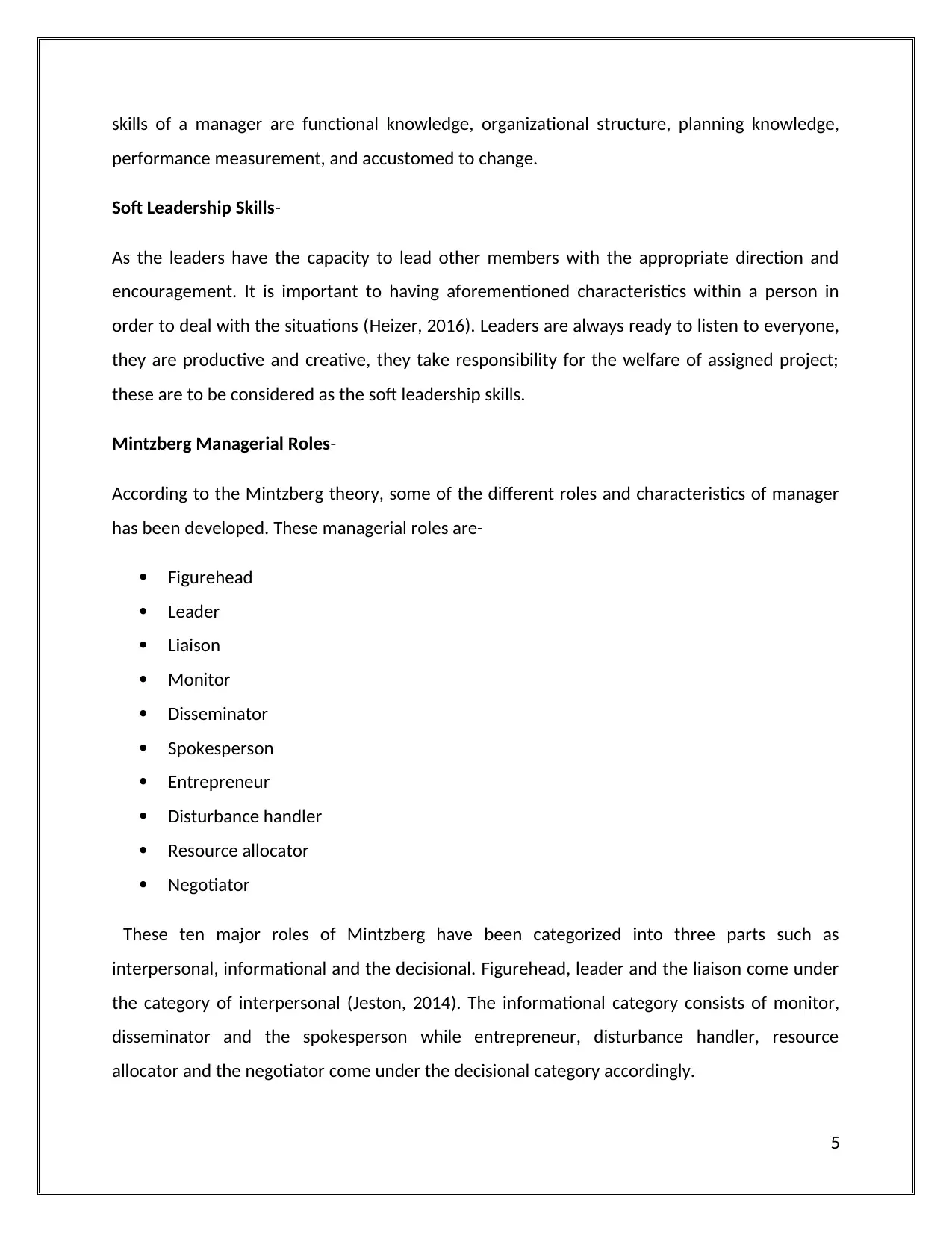
skills of a manager are functional knowledge, organizational structure, planning knowledge,
performance measurement, and accustomed to change.
Soft Leadership Skills-
As the leaders have the capacity to lead other members with the appropriate direction and
encouragement. It is important to having aforementioned characteristics within a person in
order to deal with the situations (Heizer, 2016). Leaders are always ready to listen to everyone,
they are productive and creative, they take responsibility for the welfare of assigned project;
these are to be considered as the soft leadership skills.
Mintzberg Managerial Roles-
According to the Mintzberg theory, some of the different roles and characteristics of manager
has been developed. These managerial roles are-
Figurehead
Leader
Liaison
Monitor
Disseminator
Spokesperson
Entrepreneur
Disturbance handler
Resource allocator
Negotiator
These ten major roles of Mintzberg have been categorized into three parts such as
interpersonal, informational and the decisional. Figurehead, leader and the liaison come under
the category of interpersonal (Jeston, 2014). The informational category consists of monitor,
disseminator and the spokesperson while entrepreneur, disturbance handler, resource
allocator and the negotiator come under the decisional category accordingly.
5
performance measurement, and accustomed to change.
Soft Leadership Skills-
As the leaders have the capacity to lead other members with the appropriate direction and
encouragement. It is important to having aforementioned characteristics within a person in
order to deal with the situations (Heizer, 2016). Leaders are always ready to listen to everyone,
they are productive and creative, they take responsibility for the welfare of assigned project;
these are to be considered as the soft leadership skills.
Mintzberg Managerial Roles-
According to the Mintzberg theory, some of the different roles and characteristics of manager
has been developed. These managerial roles are-
Figurehead
Leader
Liaison
Monitor
Disseminator
Spokesperson
Entrepreneur
Disturbance handler
Resource allocator
Negotiator
These ten major roles of Mintzberg have been categorized into three parts such as
interpersonal, informational and the decisional. Figurehead, leader and the liaison come under
the category of interpersonal (Jeston, 2014). The informational category consists of monitor,
disseminator and the spokesperson while entrepreneur, disturbance handler, resource
allocator and the negotiator come under the decisional category accordingly.
5
⊘ This is a preview!⊘
Do you want full access?
Subscribe today to unlock all pages.

Trusted by 1+ million students worldwide
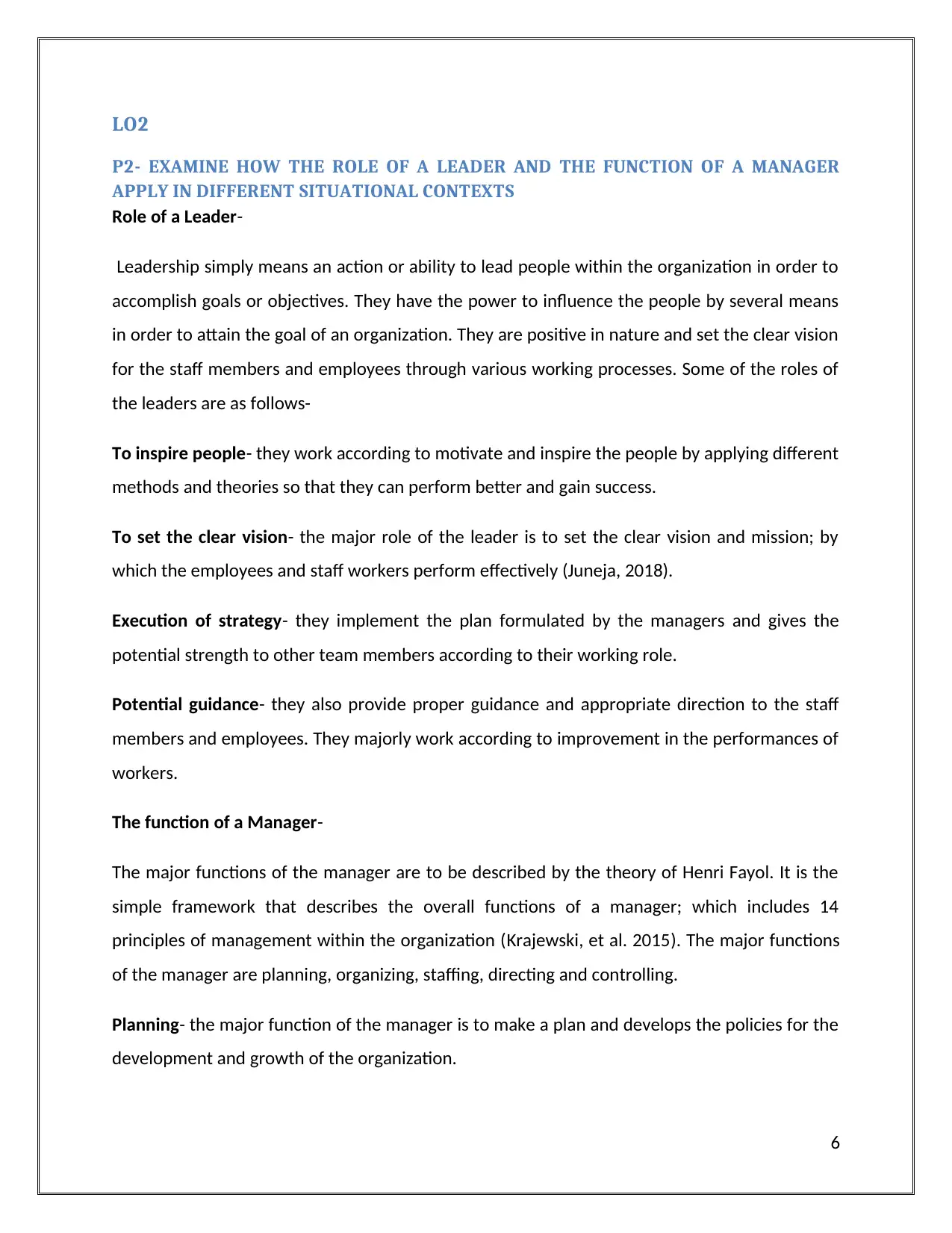
LO2
P2- EXAMINE HOW THE ROLE OF A LEADER AND THE FUNCTION OF A MANAGER
APPLY IN DIFFERENT SITUATIONAL CONTEXTS
Role of a Leader-
Leadership simply means an action or ability to lead people within the organization in order to
accomplish goals or objectives. They have the power to influence the people by several means
in order to attain the goal of an organization. They are positive in nature and set the clear vision
for the staff members and employees through various working processes. Some of the roles of
the leaders are as follows-
To inspire people- they work according to motivate and inspire the people by applying different
methods and theories so that they can perform better and gain success.
To set the clear vision- the major role of the leader is to set the clear vision and mission; by
which the employees and staff workers perform effectively (Juneja, 2018).
Execution of strategy- they implement the plan formulated by the managers and gives the
potential strength to other team members according to their working role.
Potential guidance- they also provide proper guidance and appropriate direction to the staff
members and employees. They majorly work according to improvement in the performances of
workers.
The function of a Manager-
The major functions of the manager are to be described by the theory of Henri Fayol. It is the
simple framework that describes the overall functions of a manager; which includes 14
principles of management within the organization (Krajewski, et al. 2015). The major functions
of the manager are planning, organizing, staffing, directing and controlling.
Planning- the major function of the manager is to make a plan and develops the policies for the
development and growth of the organization.
6
P2- EXAMINE HOW THE ROLE OF A LEADER AND THE FUNCTION OF A MANAGER
APPLY IN DIFFERENT SITUATIONAL CONTEXTS
Role of a Leader-
Leadership simply means an action or ability to lead people within the organization in order to
accomplish goals or objectives. They have the power to influence the people by several means
in order to attain the goal of an organization. They are positive in nature and set the clear vision
for the staff members and employees through various working processes. Some of the roles of
the leaders are as follows-
To inspire people- they work according to motivate and inspire the people by applying different
methods and theories so that they can perform better and gain success.
To set the clear vision- the major role of the leader is to set the clear vision and mission; by
which the employees and staff workers perform effectively (Juneja, 2018).
Execution of strategy- they implement the plan formulated by the managers and gives the
potential strength to other team members according to their working role.
Potential guidance- they also provide proper guidance and appropriate direction to the staff
members and employees. They majorly work according to improvement in the performances of
workers.
The function of a Manager-
The major functions of the manager are to be described by the theory of Henri Fayol. It is the
simple framework that describes the overall functions of a manager; which includes 14
principles of management within the organization (Krajewski, et al. 2015). The major functions
of the manager are planning, organizing, staffing, directing and controlling.
Planning- the major function of the manager is to make a plan and develops the policies for the
development and growth of the organization.
6
Paraphrase This Document
Need a fresh take? Get an instant paraphrase of this document with our AI Paraphraser
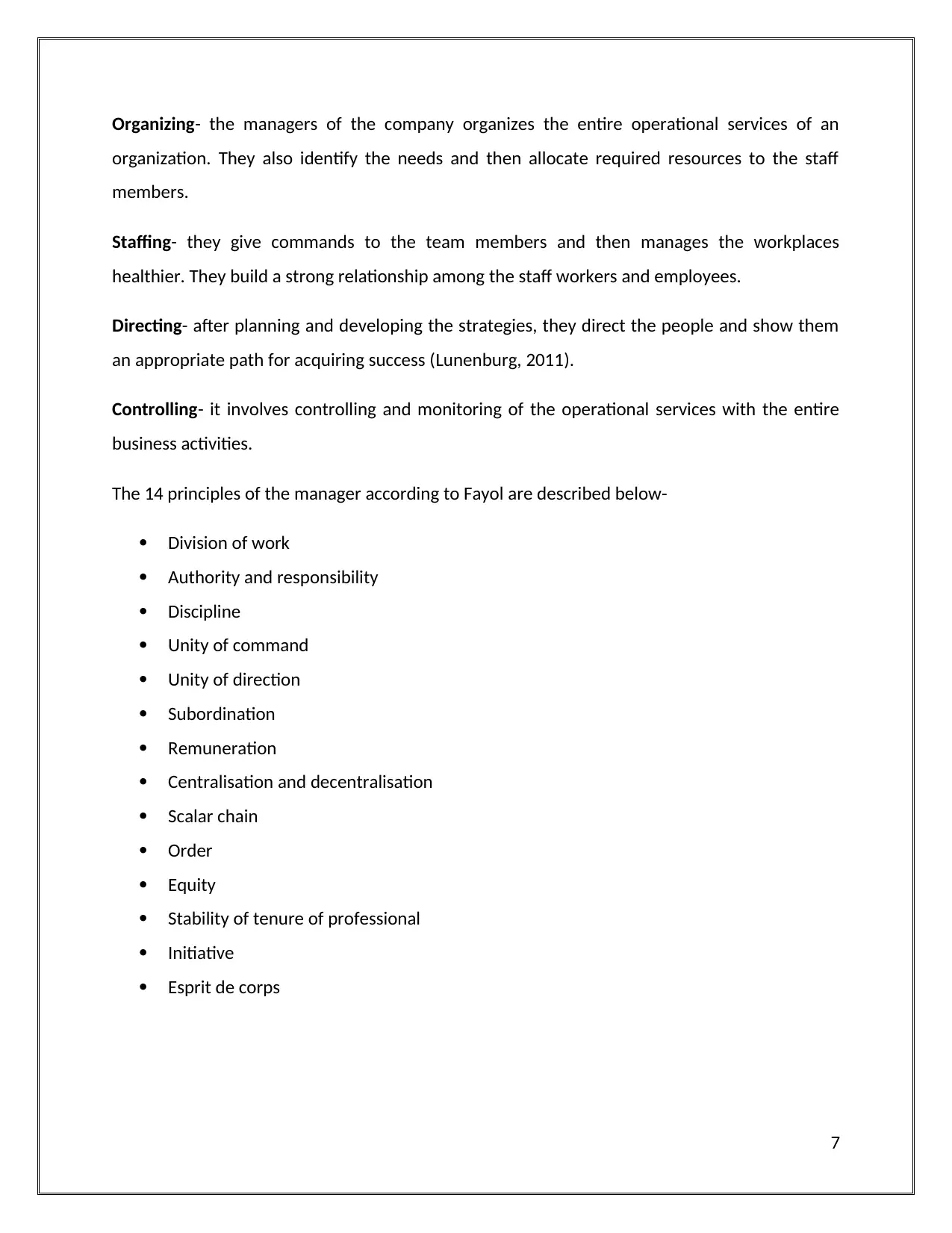
Organizing- the managers of the company organizes the entire operational services of an
organization. They also identify the needs and then allocate required resources to the staff
members.
Staffing- they give commands to the team members and then manages the workplaces
healthier. They build a strong relationship among the staff workers and employees.
Directing- after planning and developing the strategies, they direct the people and show them
an appropriate path for acquiring success (Lunenburg, 2011).
Controlling- it involves controlling and monitoring of the operational services with the entire
business activities.
The 14 principles of the manager according to Fayol are described below-
Division of work
Authority and responsibility
Discipline
Unity of command
Unity of direction
Subordination
Remuneration
Centralisation and decentralisation
Scalar chain
Order
Equity
Stability of tenure of professional
Initiative
Esprit de corps
7
organization. They also identify the needs and then allocate required resources to the staff
members.
Staffing- they give commands to the team members and then manages the workplaces
healthier. They build a strong relationship among the staff workers and employees.
Directing- after planning and developing the strategies, they direct the people and show them
an appropriate path for acquiring success (Lunenburg, 2011).
Controlling- it involves controlling and monitoring of the operational services with the entire
business activities.
The 14 principles of the manager according to Fayol are described below-
Division of work
Authority and responsibility
Discipline
Unity of command
Unity of direction
Subordination
Remuneration
Centralisation and decentralisation
Scalar chain
Order
Equity
Stability of tenure of professional
Initiative
Esprit de corps
7
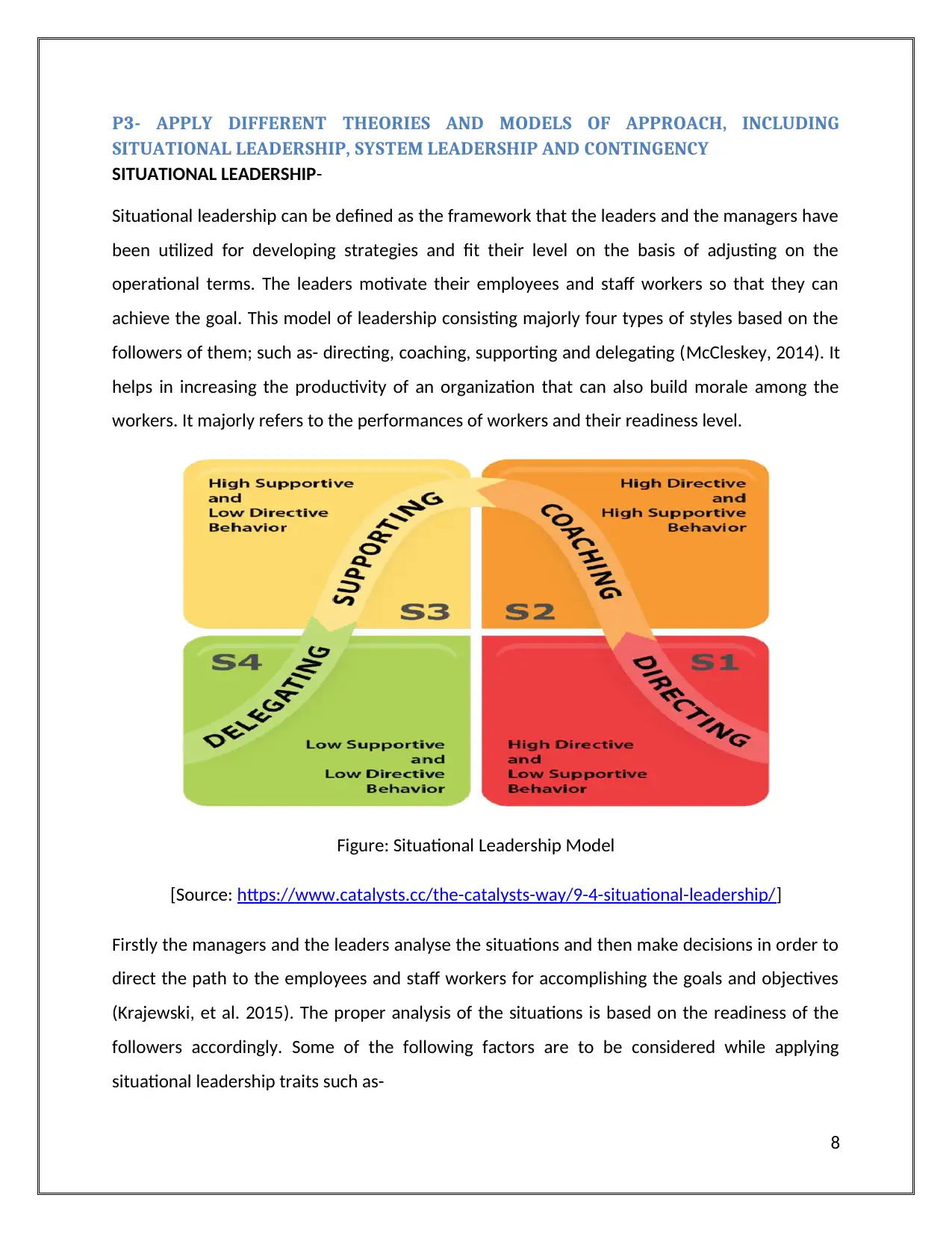
P3- APPLY DIFFERENT THEORIES AND MODELS OF APPROACH, INCLUDING
SITUATIONAL LEADERSHIP, SYSTEM LEADERSHIP AND CONTINGENCY
SITUATIONAL LEADERSHIP-
Situational leadership can be defined as the framework that the leaders and the managers have
been utilized for developing strategies and fit their level on the basis of adjusting on the
operational terms. The leaders motivate their employees and staff workers so that they can
achieve the goal. This model of leadership consisting majorly four types of styles based on the
followers of them; such as- directing, coaching, supporting and delegating (McCleskey, 2014). It
helps in increasing the productivity of an organization that can also build morale among the
workers. It majorly refers to the performances of workers and their readiness level.
Figure: Situational Leadership Model
[Source: https://www.catalysts.cc/the-catalysts-way/9-4-situational-leadership/]
Firstly the managers and the leaders analyse the situations and then make decisions in order to
direct the path to the employees and staff workers for accomplishing the goals and objectives
(Krajewski, et al. 2015). The proper analysis of the situations is based on the readiness of the
followers accordingly. Some of the following factors are to be considered while applying
situational leadership traits such as-
8
SITUATIONAL LEADERSHIP, SYSTEM LEADERSHIP AND CONTINGENCY
SITUATIONAL LEADERSHIP-
Situational leadership can be defined as the framework that the leaders and the managers have
been utilized for developing strategies and fit their level on the basis of adjusting on the
operational terms. The leaders motivate their employees and staff workers so that they can
achieve the goal. This model of leadership consisting majorly four types of styles based on the
followers of them; such as- directing, coaching, supporting and delegating (McCleskey, 2014). It
helps in increasing the productivity of an organization that can also build morale among the
workers. It majorly refers to the performances of workers and their readiness level.
Figure: Situational Leadership Model
[Source: https://www.catalysts.cc/the-catalysts-way/9-4-situational-leadership/]
Firstly the managers and the leaders analyse the situations and then make decisions in order to
direct the path to the employees and staff workers for accomplishing the goals and objectives
(Krajewski, et al. 2015). The proper analysis of the situations is based on the readiness of the
followers accordingly. Some of the following factors are to be considered while applying
situational leadership traits such as-
8
⊘ This is a preview!⊘
Do you want full access?
Subscribe today to unlock all pages.

Trusted by 1+ million students worldwide
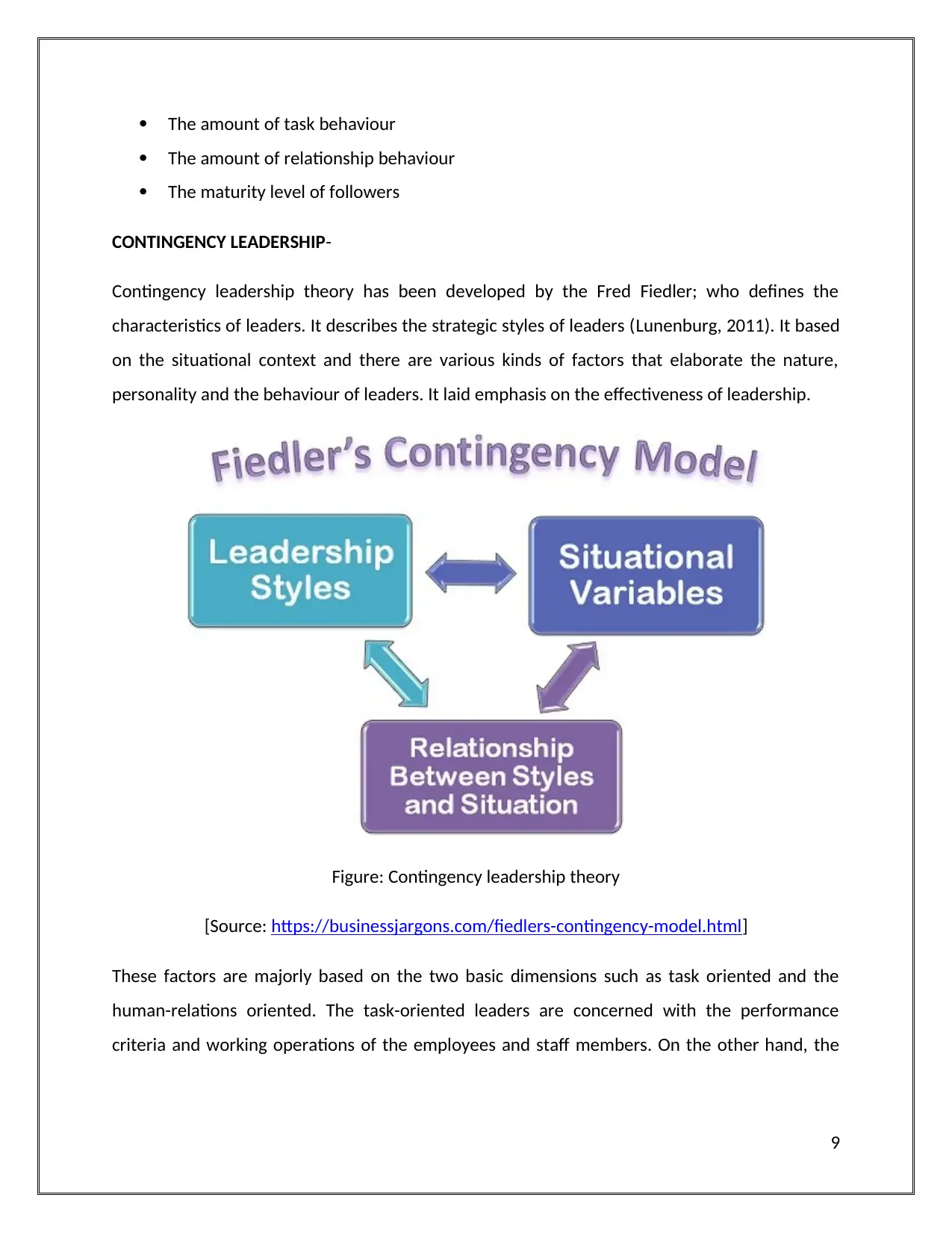
The amount of task behaviour
The amount of relationship behaviour
The maturity level of followers
CONTINGENCY LEADERSHIP-
Contingency leadership theory has been developed by the Fred Fiedler; who defines the
characteristics of leaders. It describes the strategic styles of leaders (Lunenburg, 2011). It based
on the situational context and there are various kinds of factors that elaborate the nature,
personality and the behaviour of leaders. It laid emphasis on the effectiveness of leadership.
Figure: Contingency leadership theory
[Source: https://businessjargons.com/fiedlers-contingency-model.html]
These factors are majorly based on the two basic dimensions such as task oriented and the
human-relations oriented. The task-oriented leaders are concerned with the performance
criteria and working operations of the employees and staff members. On the other hand, the
9
The amount of relationship behaviour
The maturity level of followers
CONTINGENCY LEADERSHIP-
Contingency leadership theory has been developed by the Fred Fiedler; who defines the
characteristics of leaders. It describes the strategic styles of leaders (Lunenburg, 2011). It based
on the situational context and there are various kinds of factors that elaborate the nature,
personality and the behaviour of leaders. It laid emphasis on the effectiveness of leadership.
Figure: Contingency leadership theory
[Source: https://businessjargons.com/fiedlers-contingency-model.html]
These factors are majorly based on the two basic dimensions such as task oriented and the
human-relations oriented. The task-oriented leaders are concerned with the performance
criteria and working operations of the employees and staff members. On the other hand, the
9
Paraphrase This Document
Need a fresh take? Get an instant paraphrase of this document with our AI Paraphraser
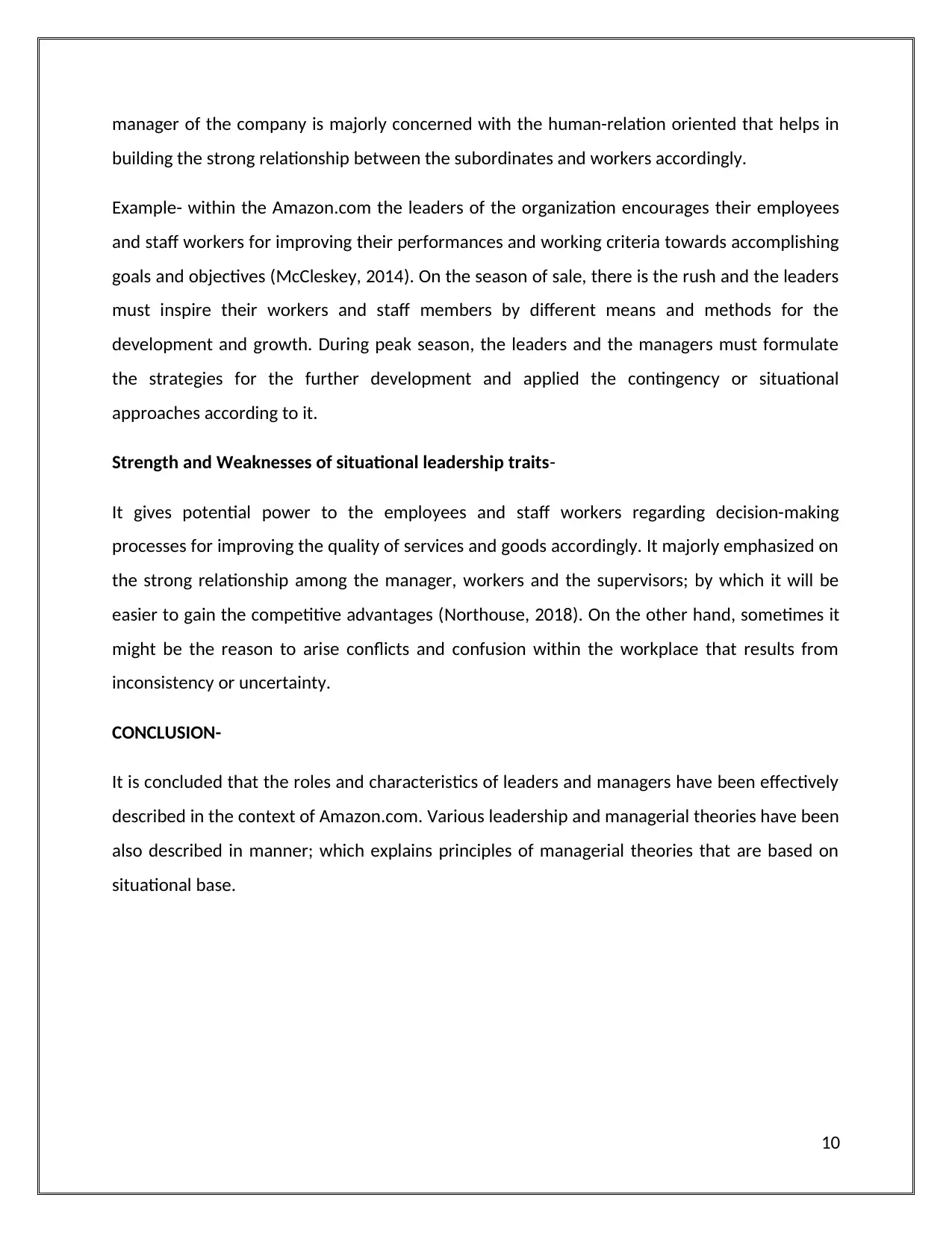
manager of the company is majorly concerned with the human-relation oriented that helps in
building the strong relationship between the subordinates and workers accordingly.
Example- within the Amazon.com the leaders of the organization encourages their employees
and staff workers for improving their performances and working criteria towards accomplishing
goals and objectives (McCleskey, 2014). On the season of sale, there is the rush and the leaders
must inspire their workers and staff members by different means and methods for the
development and growth. During peak season, the leaders and the managers must formulate
the strategies for the further development and applied the contingency or situational
approaches according to it.
Strength and Weaknesses of situational leadership traits-
It gives potential power to the employees and staff workers regarding decision-making
processes for improving the quality of services and goods accordingly. It majorly emphasized on
the strong relationship among the manager, workers and the supervisors; by which it will be
easier to gain the competitive advantages (Northouse, 2018). On the other hand, sometimes it
might be the reason to arise conflicts and confusion within the workplace that results from
inconsistency or uncertainty.
CONCLUSION-
It is concluded that the roles and characteristics of leaders and managers have been effectively
described in the context of Amazon.com. Various leadership and managerial theories have been
also described in manner; which explains principles of managerial theories that are based on
situational base.
10
building the strong relationship between the subordinates and workers accordingly.
Example- within the Amazon.com the leaders of the organization encourages their employees
and staff workers for improving their performances and working criteria towards accomplishing
goals and objectives (McCleskey, 2014). On the season of sale, there is the rush and the leaders
must inspire their workers and staff members by different means and methods for the
development and growth. During peak season, the leaders and the managers must formulate
the strategies for the further development and applied the contingency or situational
approaches according to it.
Strength and Weaknesses of situational leadership traits-
It gives potential power to the employees and staff workers regarding decision-making
processes for improving the quality of services and goods accordingly. It majorly emphasized on
the strong relationship among the manager, workers and the supervisors; by which it will be
easier to gain the competitive advantages (Northouse, 2018). On the other hand, sometimes it
might be the reason to arise conflicts and confusion within the workplace that results from
inconsistency or uncertainty.
CONCLUSION-
It is concluded that the roles and characteristics of leaders and managers have been effectively
described in the context of Amazon.com. Various leadership and managerial theories have been
also described in manner; which explains principles of managerial theories that are based on
situational base.
10
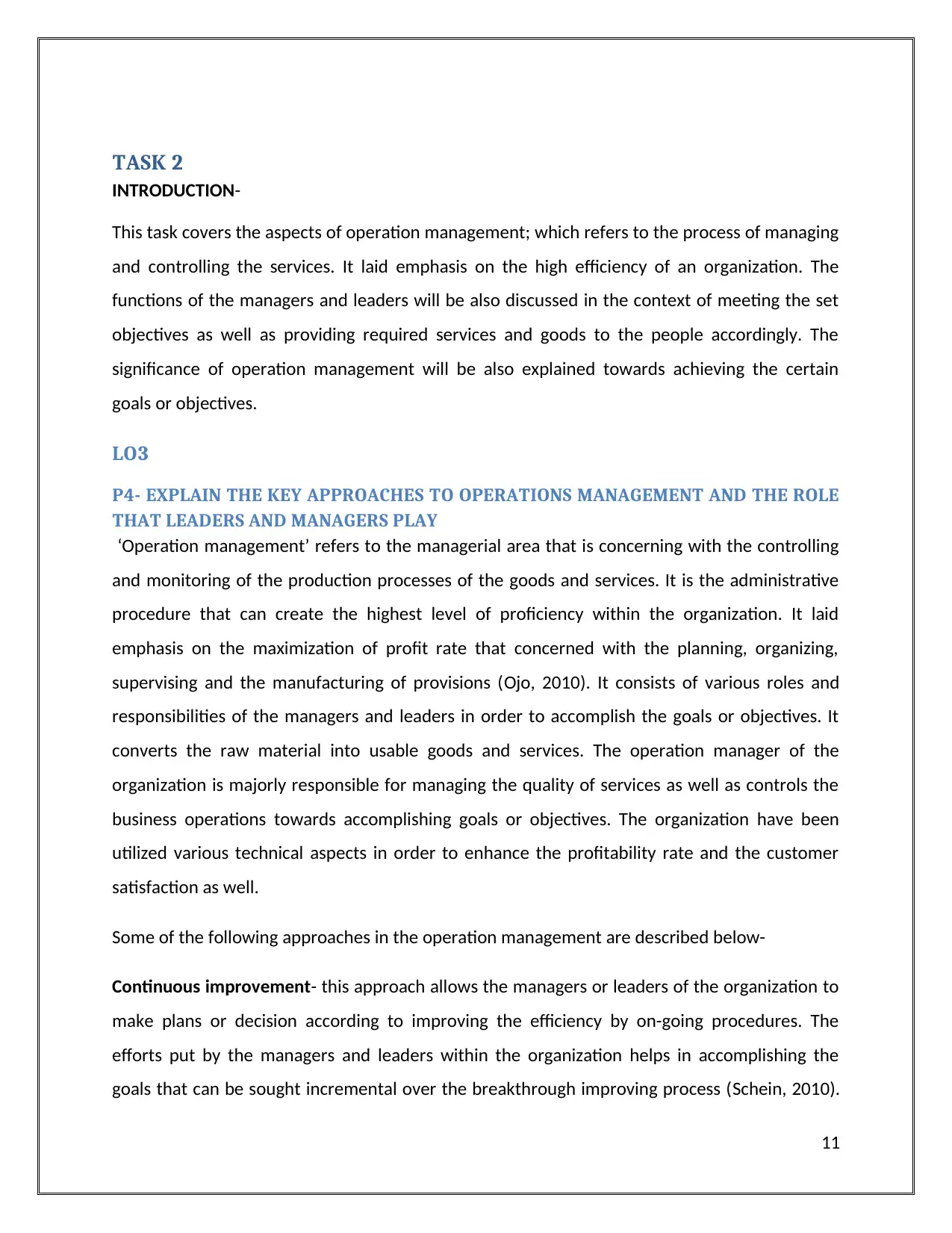
TASK 2
INTRODUCTION-
This task covers the aspects of operation management; which refers to the process of managing
and controlling the services. It laid emphasis on the high efficiency of an organization. The
functions of the managers and leaders will be also discussed in the context of meeting the set
objectives as well as providing required services and goods to the people accordingly. The
significance of operation management will be also explained towards achieving the certain
goals or objectives.
LO3
P4- EXPLAIN THE KEY APPROACHES TO OPERATIONS MANAGEMENT AND THE ROLE
THAT LEADERS AND MANAGERS PLAY
‘Operation management’ refers to the managerial area that is concerning with the controlling
and monitoring of the production processes of the goods and services. It is the administrative
procedure that can create the highest level of proficiency within the organization. It laid
emphasis on the maximization of profit rate that concerned with the planning, organizing,
supervising and the manufacturing of provisions (Ojo, 2010). It consists of various roles and
responsibilities of the managers and leaders in order to accomplish the goals or objectives. It
converts the raw material into usable goods and services. The operation manager of the
organization is majorly responsible for managing the quality of services as well as controls the
business operations towards accomplishing goals or objectives. The organization have been
utilized various technical aspects in order to enhance the profitability rate and the customer
satisfaction as well.
Some of the following approaches in the operation management are described below-
Continuous improvement- this approach allows the managers or leaders of the organization to
make plans or decision according to improving the efficiency by on-going procedures. The
efforts put by the managers and leaders within the organization helps in accomplishing the
goals that can be sought incremental over the breakthrough improving process (Schein, 2010).
11
INTRODUCTION-
This task covers the aspects of operation management; which refers to the process of managing
and controlling the services. It laid emphasis on the high efficiency of an organization. The
functions of the managers and leaders will be also discussed in the context of meeting the set
objectives as well as providing required services and goods to the people accordingly. The
significance of operation management will be also explained towards achieving the certain
goals or objectives.
LO3
P4- EXPLAIN THE KEY APPROACHES TO OPERATIONS MANAGEMENT AND THE ROLE
THAT LEADERS AND MANAGERS PLAY
‘Operation management’ refers to the managerial area that is concerning with the controlling
and monitoring of the production processes of the goods and services. It is the administrative
procedure that can create the highest level of proficiency within the organization. It laid
emphasis on the maximization of profit rate that concerned with the planning, organizing,
supervising and the manufacturing of provisions (Ojo, 2010). It consists of various roles and
responsibilities of the managers and leaders in order to accomplish the goals or objectives. It
converts the raw material into usable goods and services. The operation manager of the
organization is majorly responsible for managing the quality of services as well as controls the
business operations towards accomplishing goals or objectives. The organization have been
utilized various technical aspects in order to enhance the profitability rate and the customer
satisfaction as well.
Some of the following approaches in the operation management are described below-
Continuous improvement- this approach allows the managers or leaders of the organization to
make plans or decision according to improving the efficiency by on-going procedures. The
efforts put by the managers and leaders within the organization helps in accomplishing the
goals that can be sought incremental over the breakthrough improving process (Schein, 2010).
11
⊘ This is a preview!⊘
Do you want full access?
Subscribe today to unlock all pages.

Trusted by 1+ million students worldwide
1 out of 22
Related Documents
Your All-in-One AI-Powered Toolkit for Academic Success.
+13062052269
info@desklib.com
Available 24*7 on WhatsApp / Email
![[object Object]](/_next/static/media/star-bottom.7253800d.svg)
Unlock your academic potential
Copyright © 2020–2025 A2Z Services. All Rights Reserved. Developed and managed by ZUCOL.



